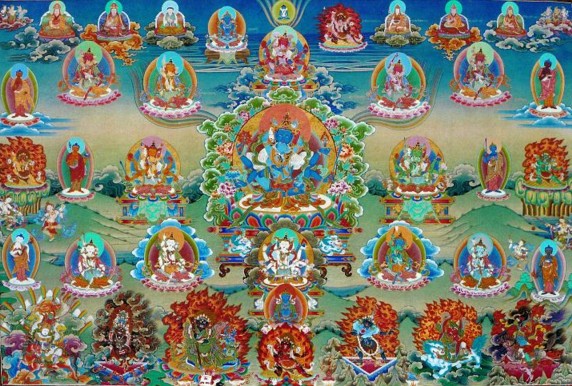Bardo: Difference between revisions
Jump to navigation
Jump to search
No edit summary |
No edit summary |
||
| Line 1: | Line 1: | ||
[[Image:Peaceful guhyagarbha.JPG|frame|Peaceful Deities from the Mandala of Hundred Peaceful and Wrathful Deities]] | |||
'''Bardo''' ([[Wyl.]] ''bar do''; Skt. ''antarābhava'') — commonly used to denote the intermediate state between death and rebirth, but in reality bardos are occurring continuously, throughout both life and death, and are junctures at which the possibility of [[liberation]], or [[enlightenment]], is heightened. | '''Bardo''' ([[Wyl.]] ''bar do''; Skt. ''antarābhava'') — commonly used to denote the intermediate state between death and rebirth, but in reality bardos are occurring continuously, throughout both life and death, and are junctures at which the possibility of [[liberation]], or [[enlightenment]], is heightened. | ||
Revision as of 12:11, 2 October 2010

Bardo (Wyl. bar do; Skt. antarābhava) — commonly used to denote the intermediate state between death and rebirth, but in reality bardos are occurring continuously, throughout both life and death, and are junctures at which the possibility of liberation, or enlightenment, is heightened.
Literal Meaning
Sogyal Rinpoche writes:
- Bardo is a Tibetan word that simply means a “transition” or a gap between the completion of one situation and the onset of another. Bar means “in between,” and do means “suspended” or “thrown.”
Divisions
The different bardos can be categorized into four or six:
The Four Bardos
| This section contains Tibetan script. Without proper Tibetan rendering support configured, you may see other symbols instead of Tibetan script. |
- the natural bardo of this life which begins when a connection with a new birth is first made and continues until the conditions that will certainly lead to death become manifest.
- the painful bardo of dying which begins when these conditions manifest and continues until the 'inner respiration' ceases and the luminosity of the dharmakaya dawns.
- the luminous bardo of dharmata which lasts from the moment the dharmakaya luminosity dawns after death and continues until the visions of precious spontaneous perfection are complete.
- the karmic bardo of becoming which lasts from the moment the bardo body is created and continues until the connection with a new rebirth is made.
The Six Bardos
The four above with the addition of:
- 5. the bardo of meditation (Skt. samādhyantarābhava; Wyl. bsam gtan gyi bar do)
- 6. the bardo of dreaming (Skt. svapanāntarābhava; Wyl. rmi lam gyi bar do)
These two bardos are part of the natural bardo of this life.
Literature
Dzogchen Tantras
- Union of the Sun and Moon (Wyl. nyi zla kha sbyor)
- Self-arising Primordial Awareness (Wyl. rig pa rang shar)
Termas
- Karma Lingpa, The Peaceful and Wrathful Deities, The Profound Dharma of Self-liberated Wisdom Mind (Wyl. zab chos zhi khro dgongs pa rang grol), which contains the Great Liberation through Hearing in the Bardo (Tib. Bardo Tödrol Chenmo; Wyl. bar do thos grol chen mo) (see English translation below)
Instruction Manuals
Commentaries
- Tsele Natsok Rangdrol, bar do spyi'i don thams cad gsal bar byed pa dran pa'i me long (see English translation below)
Further Reading
- Chögyam Trungpa, Transcending Madness: The Experience of the Six Bardos, The Collected Works of Chögyam Trungpa, Volume Six.
- Dzogchen Ponlop, Mind Beyond Death (Ithaca: Snow Lion Publications, 2006)
- His Holiness Dilgo Khyentse Rinpoche, Pure Appearance—Development and Completion Stages in the Vajrayana Practice (Halifax: Vajravairochana Translation Committee, 2002), Ch. 2 & 3. (restricted publication)
- Sogyal Rinpoche, The Tibetan Book of Living and Dying, revised and updated edition, Harper San Francisco, 2002.
- Tsele Natsok Rangdrol, Mirror of Mindfulness: The Cycle of the Four Bardos, translated by Erik Pema Kunsang (Boston & Shaftesbury: Shambhala, 1989).
- Tulku Thondup, Enlightened Journey—Buddhist Practice as Daily Life, edited by Harold Talbott (Boston: Shambhala Publications, 1995), Ch.6 'Preparing for the Bardo'.
- See the Tibetan Book of the Dead article for English translations
